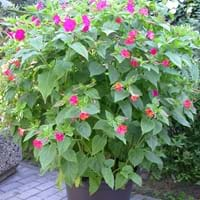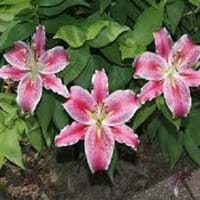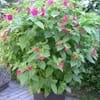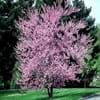Life Span
Perennial
Perennial
Type
Flowering Plants, Grass, Shrubs
Bulb or Corm or Tuber
Origin
Central America, North America
Hybrid origin
Types
Not Available
Oriental White
Pink Oriental
Light Pink Oriental
Red Oriental
Number of Varieties
Not Available
Habitat
Temperate Regions, tropical environments
gardens, Tropical regions
USDA Hardiness Zone
7-10
4-8
AHS Heat Zone
Not Available
8-1
Sunset Zone
Not Available
21,22
Habit
Upright/Erect
Upright/Erect
Flower Color
Pink, Red, White, Yellow
Pink, Magenta, Rose
Flower Color Modifier
Bicolor
Bicolor
Fruit Color
Black, Green
Green, Sandy Brown
Leaf Color in Spring
Green, Dark Green
Green
Leaf Color in Summer
Dark Green
Light Green
Leaf Color in Fall
Yellow green
Several shades of Green
Leaf Color in Winter
Dark Green
Light Green
Leaf Shape
Egg-shaped
Heart-shaped
Plant Season
Fall, Late Summer, Mid Summer
Summer
Sunlight
Full Sun
Full Sun, Partial Sun
Type of Soil
Loam, Sand
Clay, Loam, Sand
The pH of Soil
Neutral, Slightly Acidic, Slightly Alkaline
Neutral
Soil Drainage
Well drained
Average
Bloom Time
Early Fall, Late Summer, Mid Summer
Summer
Tolerances
Drought
Drought
Where to Plant?
Container, Ground, Pot
Ground, Pot
How to Plant?
Seedlings
From bulbs, From Rhizomes, Stem Planting
Plant Maintenance
Low
Medium
Watering Requirements
Do not water excessively
Keep the ground moist but not water-logged, Water more in summer, Water when soil is dry
In Summer
Lots of watering
Lots of watering
In Spring
Moderate
Moderate
In Winter
Average Water
Average Water
Soil pH
Neutral, Slightly Acidic, Slightly Alkaline
Neutral
Soil Type
Loam, Sand
Clay, Loam, Sand
Soil Drainage Capacity
Well drained
Average
Sun Exposure
Full Sun
Full Sun, Partial Sun
Pruning
Cut back old stems to the ground
Remove damaged leaves, Remove dead branches, Remove dead leaves
Fertilizers
as it is a flowering plant, use high phosphorous content fertilizer
All-Purpose Liquid Fertilizer
Pests and Diseases
Aphids, Slugs
Red blotch
Plant Tolerance
Drought
Drought
Flower Petal Number
Single
Single
Foliage Texture
Coarse
Medium
Foliage Sheen
Matte
Glossy
Attracts
Bees, Butterflies
Butterflies, Hummingbirds
Allergy
Not Available
Asthma
Aesthetic Uses
Showy Purposes, small hedge
Beautification, Bouquets
Beauty Benefits
Making cosmetics
Not Available
Environmental Uses
Not Available
Air purification
Medicinal Uses
anti-inflammatory, Aphrodisiac, Diuretic, Purgative, Vulnerary
Cough, Fever, Stomach pain, tuberculosis
Part of Plant Used
Flowers, Leaves
Flowers, Leaves
Other Uses
Edible dye
Making Perfumes, Showy Purposes, Use in Chinese herbology, Used as Ornamental plant, Used for fragrance
Used As Indoor Plant
No
Yes
Used As Outdoor Plant
Yes
Yes
Garden Design
Container, Edging, Feature Plant, Foundation, Wildflower
Container, Cutflower, Mixed Border
Botanical Name
Mirabilis jalapa
LILIUM 'Acapulco'
Common Name
marvel of peru, four o'clock flower
Acapulco Oriental Lily, Oriental Lily
In Hindi
Mirabilis jalapa
ओरिएंटल लिली
In German
Wunderblume
Orientalische Lilie
In French
Belle-de-nuit
Lily Oriental
In Spanish
Dondiego de noche
lirio oriental
In Greek
mirabilis Jalapa
Oriental Lily
In Portuguese
Maravilha
Lily Oriental
In Polish
mirabilis Jalapa
Oriental Lily
In Latin
mirabilis Ja-
Oriental Lily
Phylum
Magnoliophyta
Not Available
Class
Magnoliopsida
Not Available
Order
Caryophyllales
Liliales
Family
Nyctaginaceae
Liliaceae
Clade
Angiosperms, Core eudicots, Eudicots
Angiosperms, Monocots
Tribe
Not Available
Lilieae
Subfamily
Not Available
Lilioideae
Number of Species
Not Available
Difference Between Mirabilis Jalapa and Oriental Lily
If you are confused whether Mirabilis Jalapa or Oriental Lily are same, here are some features about those plants to help you choose better. Many people think that these two plants have the same characteristics, but one can see Mirabilis Jalapa and Oriental Lily Information and learn more about it. Fertilizers required for proper growth of Mirabilis Jalapa are as it is a flowering plant, use high phosphorous content fertilizer, whereas for Oriental Lily fertilizers required are All-Purpose Liquid Fertilizer. Hence, one should know the basic difference between Mirabilis Jalapa and Oriental Lily if you are planning to have them in your garden to enhance its beauty.
<
Flowering PlantsImportance of Mirabilis Jalapa and Oriental Lily
Want to have the most appropriate plant for your garden? You might want to know the importance of Mirabilis Jalapa and Oriental Lily. Basically, these two plants vary in many aspects. Compare Mirabilis Jalapa and Oriental Lily as they differ in many characteristics such as their life, care, benefits, facts, etc. Every gardener must at least have the slightest clue about the plants he wants to plant in his garden. Compare their benefits, which differ in many ways like facts and uses. The medicinal use of Mirabilis Jalapa is anti-inflammatory, Aphrodisiac, Diuretic, Purgative and Vulnerary whereas of Oriental Lily is Cough, Fever, Stomach pain and tuberculosis. Mirabilis Jalapa has beauty benefits as follows: Making cosmetics while Oriental Lily has beauty benefits as follows: Making cosmetics.
Compare Facts of Mirabilis Jalapa vs Oriental Lily
How to choose the best garden plant for your garden depending upon its facts? Here garden plant comparison will help you to solve this query. Compare the facts of Mirabilis Jalapa vs Oriental Lily and know which one to choose. As garden plants have benefits and other uses, allergy is also a major drawback of plants for some people. Allergic reactions of Mirabilis Jalapa are Not Available whereas of Oriental Lily have Asthma respectively. Having a fruit bearing plant in your garden can be a plus point of your garden. Mirabilis Jalapa has no showy fruits and Oriental Lily has no showy fruits. Also Mirabilis Jalapa is not flowering and Oriental Lily is not flowering . You can compare Mirabilis Jalapa and Oriental Lily facts and facts of other plants too.





